 |
links to other FAQ pages
[ V8 Engine Fitting Information ] [ Rover 3.5, 3.9, 4.2 to 4.6 Conversion ] [ LPG Conversion details ] [ Fuel Injection Section ]
[ Weber 500 & SU Carbs ] [ Mallory Ignition Systems ] [ General Engine Problems ] [ General Information ]

|
 |
| FAQ Weber 500 Carb Kit |
 |
|
|
|
 Why do you recommend the Weber 500? Why do you recommend the Weber 500? |
 > SU Carburettors have become very expensive new if indeed you can stil get them, and used ones in good order are becoming almost mythical, > SU Carburettors have become very expensive new if indeed you can stil get them, and used ones in good order are becoming almost mythical,
Twin SU's can be used even up to 4.6 litre (4WD) application non-race/high- torque) but it is advisable to at least recondition them, and essential to re-jet them accordingly (even for a camshaft or similar improvement). This should best be considered as something that will 'work' [hopefully] until the Weber or Optimized Injection can be purchased.
 Fuel Injection, in the above information, I offer a comparison between optimized and 'non-standard' injection. The reason is that most second-hand injection systems (after you have shelled out good money) are far from adequate (you can find more info on this FAQ site) and, if you don't already have it fitted, you will find it's far more expensive and more complicated to fit than most would have you believe (especially the seller). So, again, in most case I would recommend the Weber. Fuel Injection, in the above information, I offer a comparison between optimized and 'non-standard' injection. The reason is that most second-hand injection systems (after you have shelled out good money) are far from adequate (you can find more info on this FAQ site) and, if you don't already have it fitted, you will find it's far more expensive and more complicated to fit than most would have you believe (especially the seller). So, again, in most case I would recommend the Weber.
 Difficulty associated with added EFi to non EFi Motors, when comparing with Weber option. Converting to injection (if not injection already) & unless you can get hold of a later 3.9 set up, and then spend loads on it, it won't come near to the simplicity and 'Plug and Play' power, as accociated with a simple conversion to the Weber 500, system.. Difficulty associated with added EFi to non EFi Motors, when comparing with Weber option. Converting to injection (if not injection already) & unless you can get hold of a later 3.9 set up, and then spend loads on it, it won't come near to the simplicity and 'Plug and Play' power, as accociated with a simple conversion to the Weber 500, system..
 Some reasons why. The early 3.5 injection systems were quite crude by modern standards and most parts will need reconditioning. The Later 3.9 systems are much better, but costs will be incurred on top as 'chipping', 'reappropriation' & 'reconditioning' costs would need to be considered, and fitting of injection systems to non-injected engines means machining to head intake ports is essential. Some reasons why. The early 3.5 injection systems were quite crude by modern standards and most parts will need reconditioning. The Later 3.9 systems are much better, but costs will be incurred on top as 'chipping', 'reappropriation' & 'reconditioning' costs would need to be considered, and fitting of injection systems to non-injected engines means machining to head intake ports is essential.
Fitting/converting would also require vehicle modifications both to fuel tank, fuel pump, fuel lines, Electrics and many plumbing & other issues under the bonnet, plus there are likely to be many small parts and linkage problems. Oh, and you would need to fit a fuel pressure regulator and recondition or replace the injectors (assuming the injection system is not already new).
 Notwithstanding the above, for 'real' highest power upgrades, the later 3.9 system (chipped with 4.6 air-mass meter and ported intake, ( bigger throttle body etc.) takes some beating, but you need a reasonable budget to get the best or near best, a second hand system would need to go this far to get parity with the far simpler Weber conversion Notwithstanding the above, for 'real' highest power upgrades, the later 3.9 system (chipped with 4.6 air-mass meter and ported intake, ( bigger throttle body etc.) takes some beating, but you need a reasonable budget to get the best or near best, a second hand system would need to go this far to get parity with the far simpler Weber conversion
Weber 500, so often the best choice
|
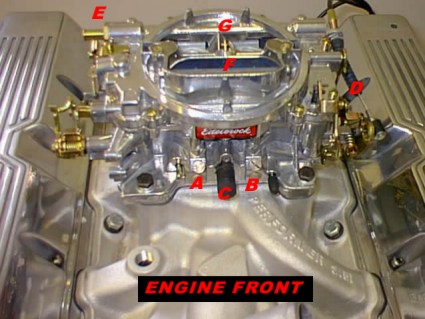 |
| Recognizing some of the key parts of the Weber 500, (1404). & 600 (1406). Carb. conversions. |
A & B >are idle mixture adjusting screws,> Best way to set is screw in completely & then about 2 full turns out and whilst checking co level from exhaust, turn out evenly to enrich or in to weaken.
C > Another vacuum port which we normally blank off and although some may use as a breather port we have found over the years that plumbing the rocker breathers to the base of the air cleaner far more effective.
D > is throttle linkage.( normally supplied)
E > is Petrol feed connection.
F > is primary side ( small side) or the carb and the flap on the top is the choke flap
G > Is the secondary stage or the carb,
Left of 'A'. You can see a small vacuum port ( timed) that is used for the distributor vacuum connection.
Right of 'B'. You can see another small port ( this one is constant vacuum) and should not be used for vacuum connection as you can see in this picture it is also blanked off. A suitable use for this port would be vacuum controlled devises such as vacuum operated Diff. locks etc for 4WD use if needed.
| Why Weber / Edelbrock 500, and not Holley. |
The Holley has never been too good at being flexible when it comes to the Rover V8 engine and it was always a little too small for large, powerful V8's, and a little too big for smaller, more economically minded V8s. Then came the Weber Edelbrock carb system, and a 200-500 cfm variable has turned out to be a real winner for part throttle economy with Throttle response, Torque and BHP gains throughout the entire rev range, and with very smooth and enormous top-end potential on any engine up to 5.2 Litre.
|
|
 Weber 500 does it work well off-road? Weber 500 does it work well off-road? |
 This is an area with little information available, but in our case the truth is out there working, Among many other successful applications and many hundreds of units sold, we sponsor a 4.6 Rally 4WD in Dubia that has been using the Weber 500 with Edelbrock High Rise intake for over 2 years. It provides huge torque for race-spec 4WD off-roading, and has superb manners when on road in between rally sections. This vehicle is expected to leap from 60 ft. Sand dunes and take sliding corners at flat-out speeds. (4.6 RPi Race Spec Engine) and the results with the Weber are superb: no flat spots, no stalling engine, no loss of power and with unrivalled throttle response. This is an area with little information available, but in our case the truth is out there working, Among many other successful applications and many hundreds of units sold, we sponsor a 4.6 Rally 4WD in Dubia that has been using the Weber 500 with Edelbrock High Rise intake for over 2 years. It provides huge torque for race-spec 4WD off-roading, and has superb manners when on road in between rally sections. This vehicle is expected to leap from 60 ft. Sand dunes and take sliding corners at flat-out speeds. (4.6 RPi Race Spec Engine) and the results with the Weber are superb: no flat spots, no stalling engine, no loss of power and with unrivalled throttle response.
A reason for this may be the location of the Float Bowls. On the Holley (renowned for problems off-road) the float bowls are mounted front and rear, this means that when on steeper inclines the fuel transfer hole becomes flooded or starved and would normally lead to engine stalling, but on the Weber the float bowls are mounted on the sides and the fuel transfer is in the centre, so no adverse affects are experienced on steep inclines. This makes good sense as all off-road vehicles can stand steeper climbs and descents (rather than traversing around steep inclines) before becoming overbalanced.
I have also used my Own 4.6 Range Rover with the Weber 500 / Edelbrock for over 9000miles, travelling all over and subjecting it to all work loads, including Drag Racing, Off Roading, Being a Farm Tractor (see picture gallery), Swimming, Comp. Safari'ing, oh and normal road use too and, depending on my driving style, I always got ...
Huge Torque for pulling power and steep inclines
Excellent Economy (up to 23mpg (4.6 Stage 3 Engine) on part throttle and cruise driving.
Superb performance, (0-60 in 7.8 Seconds) and 100 up in less than 25 seconds (only when economy did not matter).
Simple to install, set up & maintain (we now have an LPG converter available for the Weber 500).
|
 Which Vacuum port to use. for the distributor. Which Vacuum port to use. for the distributor. |
 There are 2 vac pipes on the Weber, which one do I use the left or the right? There are 2 vac pipes on the Weber, which one do I use the left or the right?
It needs to be on the left hand one, when viewed from in front, this port should have no vacuum influence at idle. The right hand side port has vacuum all the time & can be used for our LPG active mixer (if you are running LPG as well as petrol) or other vacuum dependant devices such as Diff-Lock etc.
|
|
 On the Edelbrock carb there is a "PCV", port on the front and a "Power brake port", on the back. Which pipes should I connect to these outlets? On the Edelbrock carb there is a "PCV", port on the front and a "Power brake port", on the back. Which pipes should I connect to these outlets? |
 If its a PCV type connection it will be used for a brake servo, otherwise just blank it. If its a PCV type connection it will be used for a brake servo, otherwise just blank it.
|
|
 On the Performer intake manifold (part no- Edelbrock 2198), there is no place to connect the vacuum pipe from the diff lock. Where should this pipe go? On the Performer intake manifold (part no- Edelbrock 2198), there is no place to connect the vacuum pipe from the diff lock. Where should this pipe go? |
 You can use the right hand vacuum port in the carb. or drill and tap you own into the manifold. You can use the right hand vacuum port in the carb. or drill and tap you own into the manifold.
|
|
 Weber 500 needs re-jetting? Weber 500 needs re-jetting? |
 Although this would normally be a problem with SU, Stromberg or Holley, Carb choices. The Weber 500 system, is so very simple to jet that we can even do it for you prior to dispatch Although this would normally be a problem with SU, Stromberg or Holley, Carb choices. The Weber 500 system, is so very simple to jet that we can even do it for you prior to dispatch
We have all jet & needle sizes and data for almost all Rover V8 engine specifications that we can normally get things spot on first time. If not we will send replacement needles, jets to fit yourself, and even if you have changed your engine spec, you only pay once.
|
|
 Weber 500 Carb, does it need a special thermostat housing? Weber 500 Carb, does it need a special thermostat housing? |
 Re-use, of your original thermostat housing, does not allow the water outlet from the rear of the water pump to pass coolant through the intake manifold (on some original Rover intakes it appears to go underneath, but it actually opens up into the manifold in the center, (underside) ). Re-use, of your original thermostat housing, does not allow the water outlet from the rear of the water pump to pass coolant through the intake manifold (on some original Rover intakes it appears to go underneath, but it actually opens up into the manifold in the center, (underside) ).
Rover intakes have always and necessarily had this type of coolant bypass allowing for a slight volume of coolant to continuously circulate even when the thermostat is shut. without this required feature, incomplete Weber installations kits will lead to problems with coolant circulation and higher engine running temperatures,.
Ever wondered, why? Some Carb Kits cost more than others ?.
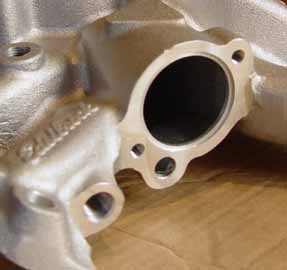
|
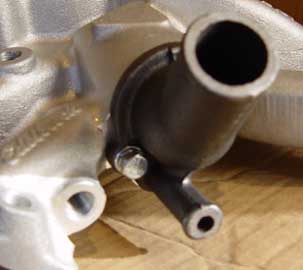
|
Here, you can see the the two threaded holes for the thermostat housing, plus the additional water intake port, @ the '7 o'clock' position,
There are two suitable type's of thermostat housing available in our kit,
'read on'.
|
This type 'Shown', is generally correct for most 2-wd application's.. ie, P5, P6, SDi, MG, (inc MG'RV8), TR8, Morgan plus 8 & most 2-wd. Kit Cars..
Notice the additional water pipe corresponding to the manifolds coolant intake port.
|
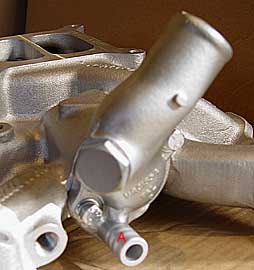
|
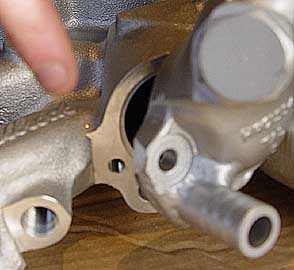
|
The four wheel drive version of our thermostat housing range, is one that we have manufactured in-house & is unique for Land Rover and Range Rover applications,
Note the angle of the top-water-hose is changed in direction plus the additional inclusion of a water temp sender, boss (there if you need it)...
|
Because of slight imperfections/variations in the castings of both intake manifold and the thermostat 4wd
housing , some metal reduction may be require in the area of the housing shown, here
Dont worry,
It wont invalidate your warranty !!!
|
|
|
 How to easily test for Weak/Rich mixture (manual choke systems only)? How to easily test for Weak/Rich mixture (manual choke systems only)? |
 Advice applies to Holley, Webber, SU & Zenith Stromberg Carburettors, and is critical for good engine torque economy, and efficiency (regardless of how much you spent on other expensive bits). Advice applies to Holley, Webber, SU & Zenith Stromberg Carburettors, and is critical for good engine torque economy, and efficiency (regardless of how much you spent on other expensive bits).
The CO & HC Emission test/set-up that you may have had carried out for your MOT or Service, can be quite misleading. The reason for this is that they are generally only tested at idle, or low RPM. When tested at idle this has very little reference to your actual fuel mixture when driving, as the carburettor will now be reliant on its needle and valve profile to correctly supply the most efficient fuel/air ratio at all engine speeds and load conditions. When tested at low RPM this is only relevant to low-speed, low-engine load conditions and again cannot be of great importance.
One way of telling how the mixtures are, without putting it on a rolling road is to introduce a little choke at varying engine loads, and see how it responds. To See: 1, If the performance stays the same 2, it it floods/loses power. 3, of if a power response is apparent. This should indicate any weak mixture areas quite well, and a richer needle should be selected. If giving choke makes no difference then you could go slightly weaker on the needles to optimize, but only one stage would be advisable. If giving choke worsens things, then this is a sure indicator of an already rich mixture that should be dealt with. Also be aware you may get different results at different engine rpm's load and choke settings, all data is quite relevant to getting a good idea of what's happening (who needs expensive equipment?).
If you find that you or your engineer are having some problem getting both low HC's and Low CO's this is likely to be a sign of worn cam lobe[s] (normally affecting only one or two cylinders so enriching or weakening 4/8 Cyl's at once would cause the 7/8 good cylinders to run weak/rich (depending on which way you adjusted to compensate)), or a problem with you ignition Spark Intensity or Timing (including correct advance systems) (see relevant section).
The best engines are always those that are set up properly with components that are well matched and well suited to all other aspects of the engine in which they are required to work, and, very importantly, your actual driving requirements. Even a Ferrari or Lamborghini engine would be slow with an inappropriate or badly set up carb/injection system.
Some fitting questions answered
|
Throttle cable and Ratio. ( not normally an issue.)
 With my LHD Range Rover, the link for throttle does not install correctly - it seems like the throttle pedal has a shorter movement than the cable / carburetor fittings are supposed to have. The result of this problem is that when putting the throttle pedal to the floor, it is still missing about 30% of maximum travel on the carburetor (this means the two extra ports on the carb does not open...). With my LHD Range Rover, the link for throttle does not install correctly - it seems like the throttle pedal has a shorter movement than the cable / carburetor fittings are supposed to have. The result of this problem is that when putting the throttle pedal to the floor, it is still missing about 30% of maximum travel on the carburetor (this means the two extra ports on the carb does not open...).
 Because many vehicle use different throttle pedal leverage ratios, this can be a problem, but easy to rectify. If you drill further up the carb linkage and relocate the throttle cable connection. You can easily correct the ration between pedal travel and carb throttle opening ( you may need to bend/re-shape the linkage to accommodate the changed fixing. Because many vehicle use different throttle pedal leverage ratios, this can be a problem, but easy to rectify. If you drill further up the carb linkage and relocate the throttle cable connection. You can easily correct the ration between pedal travel and carb throttle opening ( you may need to bend/re-shape the linkage to accommodate the changed fixing.
Throttle Linkage, modify for lower JWR Manifold.
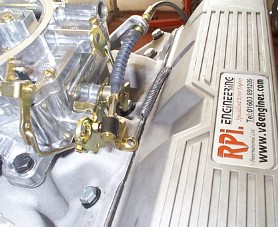 |
|
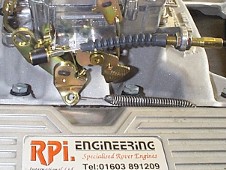
You can see from these two close up pictures, that when using the lower JWR Offenhauser Manifold it is required to bend the throttle linkage as shown and to affix the throttle return spring to the rocker cover fixing bolt., as shown from both these close up views. |
| |
Fuel line connection issues.
 Lack of fuel lines forced me to use the Y-link supplied on the old carburetors (in order to successfully couple the fuel pipe to the carburetor, and keep the link back to the fuel tank). This solution is not very proper.. Should the kit not include these parts too? Lack of fuel lines forced me to use the Y-link supplied on the old carburetors (in order to successfully couple the fuel pipe to the carburetor, and keep the link back to the fuel tank). This solution is not very proper.. Should the kit not include these parts too?
 The Kit comes with the required union to connect existing fuel hoses, however there are many variations of connection methods, In addition, utilizing the return feed to the tank is a good option but restricting it may be required, Strangely enough the replaceable tip of a Mig.. Welder has the perfect minimal internal diameter and correct external diameter to make this the almost perfect restrainer. The Kit comes with the required union to connect existing fuel hoses, however there are many variations of connection methods, In addition, utilizing the return feed to the tank is a good option but restricting it may be required, Strangely enough the replaceable tip of a Mig.. Welder has the perfect minimal internal diameter and correct external diameter to make this the almost perfect restrainer.
Unrestricted return flow may, in extreme cases, cause carb fuel starvation at higher rpm, if you don't restrict the return fuel flow in this way.
Notwithstanding this, if your fuel pump pressure is not to high the a return feed may not be needed at all so you either not use it or blank it off.
The many breather pipe(s) arrangement(s) / option(s).
 There are rather more pipes on the old carb/manifold than the new one, and I am uncertain what to do with the extras: There are rather more pipes on the old carb/manifold than the new one, and I am uncertain what to do with the extras:
 Anything not required can simply be blanked off, its a universal carb so is not specific to all fitment's but is designed & supplied to fit all manner of Rover V8 applications. Anything not required can simply be blanked off, its a universal carb so is not specific to all fitment's but is designed & supplied to fit all manner of Rover V8 applications.
 The pipe from the top of the radiator to the top of the manifold where the Solex carbs attach: I presume this can be blocked off but what should I use to stop up the outlet from the radiator? The pipe from the top of the radiator to the top of the manifold where the Solex carbs attach: I presume this can be blocked off but what should I use to stop up the outlet from the radiator?
 Block it off, best to have it soldered properly but simpler ways are available I will leave you to think what's best. Block it off, best to have it soldered properly but simpler ways are available I will leave you to think what's best.
 The Pulse air pipes which attach to the air inlet side of the old Strombergs. Should I just block these up too? The Pulse air pipes which attach to the air inlet side of the old Strombergs. Should I just block these up too?
 You can block them off on the head if you want, it's tidier & we can supply blanking screws if you want. You can block them off on the head if you want, it's tidier & we can supply blanking screws if you want.
 What should I do with the breather pipe which attaches from the back of the block (via an inlet filter) to the air cleaner? What should I do with the breather pipe which attaches from the back of the block (via an inlet filter) to the air cleaner?
 Leave it able to breath, but it need not go through the air filter box as before, We can supply a small pipe and filter that go direct onto the cover if you wish Leave it able to breath, but it need not go through the air filter box as before, We can supply a small pipe and filter that go direct onto the cover if you wish
 I presume the two rocker cover re-breather pipes should be joined together via a suitable connector and attached to the underside of the new aircleaner via the supplied connector? I presume the two rocker cover re-breather pipes should be joined together via a suitable connector and attached to the underside of the new aircleaner via the supplied connector?
 You got it! You got it!
 In the kit there is a "Plenum", hose (part no: ERC9116). Does this connect between the breather on the rocker cover and the underside of the air filter? In the kit there is a "Plenum", hose (part no: ERC9116). Does this connect between the breather on the rocker cover and the underside of the air filter?
 There are many breather options on the 40 year variants of Rocker covers so some will need different or further pipes but the idea is to breath at least one of the rocker cover large bore outlets into the Air cleaner. There are many breather options on the 40 year variants of Rocker covers so some will need different or further pipes but the idea is to breath at least one of the rocker cover large bore outlets into the Air cleaner.
More on fuel return. .
 Is it necessary to plumb in the fuel return line? At the moment I have it blocked off but will the carburetor tend to flood at part throttle openings without it connected? No unless you are using a very strong pump that would cause the carb to leak from the Float Bowl, Is it necessary to plumb in the fuel return line? At the moment I have it blocked off but will the carburetor tend to flood at part throttle openings without it connected? No unless you are using a very strong pump that would cause the carb to leak from the Float Bowl,
 There is no need for a return unless the fuel pump is delivering a pressure that is too high (above 5-6psi) or the fuel supply is running very close to a hot area that may cause the Fuel to vaporize in the line, (thus a return enabling circulation would stop this from happening), but in most cases a return is not normally required. There is no need for a return unless the fuel pump is delivering a pressure that is too high (above 5-6psi) or the fuel supply is running very close to a hot area that may cause the Fuel to vaporize in the line, (thus a return enabling circulation would stop this from happening), but in most cases a return is not normally required.
Water pipes and manifolds.
 Are there any hoses available with the correct bends? I am currently using the metal pipe under the manifold and the two rear hoses which Rover used. But at the front I have cut my own from the hose supplied. I couldn't figure out how else to do it. The standard hoses did not appear to come close enough. (The hoses I have trimmed from the length of hose are rather "strangulated")? Are there any hoses available with the correct bends? I am currently using the metal pipe under the manifold and the two rear hoses which Rover used. But at the front I have cut my own from the hose supplied. I couldn't figure out how else to do it. The standard hoses did not appear to come close enough. (The hoses I have trimmed from the length of hose are rather "strangulated")?
 There are so many variants on the same theme it would not be possible to supply hoses with correct bends for the many hundreds of different type vehicles these carbs get fitted to. Although we have an easy solution for all. There are so many variants on the same theme it would not be possible to supply hoses with correct bends for the many hundreds of different type vehicles these carbs get fitted to. Although we have an easy solution for all.
Thermostat housing. (Two types)
 The thermostat housing you supplied has a small pipe stub cast into it, can you tell me where this should be connected to? The thermostat housing you supplied has a small pipe stub cast into it, can you tell me where this should be connected to?
 To one of the water pump outlet pipes as it passes through the intake on the way to the heater, whilst the other goes under it or around. We would normally know which one to supply for your needs, To one of the water pump outlet pipes as it passes through the intake on the way to the heater, whilst the other goes under it or around. We would normally know which one to supply for your needs,
Vacuum port & Servo connection.
 The technician fitted the blanking plug to the PCV port on the carb rear and explained I would not need it. The technician fitted the blanking plug to the PCV port on the carb rear and explained I would not need it.
 The Offenhauser manifold has a threaded port directly below this area, should I be using this for my servo take-off, and if so do you have a fitting to suit (I will modify a Rover part if necessary). You can use either not both, the Std Rover one from your existing intake should fit. The Offenhauser manifold has a threaded port directly below this area, should I be using this for my servo take-off, and if so do you have a fitting to suit (I will modify a Rover part if necessary). You can use either not both, the Std Rover one from your existing intake should fit.
Water pipe ( manifold/thermostat) connection issues if converting from EFi
  ( Info only) ( Water pipes from water pump 3.9 EFi model Variants - 3.9 EFi models. You will need to check that the back of your water pump has both outlets, If it only has only one outlet ( the other being blocked off) then remove the core plug to open up the second one, this has to be done before the manifold is fitted. As you may see from the pictures The 3.9 Serpentine type has a completely different set up as you can see from these 2 pictures but plumbing is still basically the same., the water hose is connected to 1. Radiator, 1. Expansion tank, 1. Heater pipe and 1. Water pump. More on this soon. ( Info only) ( Water pipes from water pump 3.9 EFi model Variants - 3.9 EFi models. You will need to check that the back of your water pump has both outlets, If it only has only one outlet ( the other being blocked off) then remove the core plug to open up the second one, this has to be done before the manifold is fitted. As you may see from the pictures The 3.9 Serpentine type has a completely different set up as you can see from these 2 pictures but plumbing is still basically the same., the water hose is connected to 1. Radiator, 1. Expansion tank, 1. Heater pipe and 1. Water pump. More on this soon.
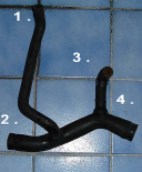 |
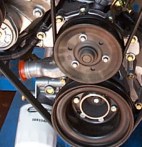 |
Serp. type hose is different.
as you can see from this layout. |
Serp type water pump is very
different to all pre-1996 engines. |
Feedback and issues addressed
|
 For 1986 R.R. V8 into MGB, the Edelbrock manifold I got from you has a thermostat housing with bypass outlet. This feature is not on all housings, so do I need to plumb it in or can I blank it off? If [that's] needed where do I go into it, the second blanked off outlet on the back of the pump or do I make an inlet in the top hose? For 1986 R.R. V8 into MGB, the Edelbrock manifold I got from you has a thermostat housing with bypass outlet. This feature is not on all housings, so do I need to plumb it in or can I blank it off? If [that's] needed where do I go into it, the second blanked off outlet on the back of the pump or do I make an inlet in the top hose?
 This is to pass water through the intake as required, if you did not purchase (or do not have) the special Thermostat housing you will need to procure one. This is to pass water through the intake as required, if you did not purchase (or do not have) the special Thermostat housing you will need to procure one.
You can use it as it is for now, but air locks may be difficult to clear and the manifold will not run at the most ideal temperature for correct fueling.
Actually Weber/Edelbrock themselves don't use the appropriate one at all and just blank it off as you suggested, but I can assure you this is not the best or correct way to do it.
 Hi Chris After a bit of fannying about to get the heater plumbed in I've got the Edelbrock/Offenhauser kit installed. I was pleasantly surprised when it started FIRST TIME! It idles smoothly and pulls like a train when the throttle is wide open. But I've got a problem with cruising at small throttle openings and light acceleration. When cruising - doesn't matter what speed -it 'jerks' as if the throttle was being opened and closed. And when accelerating, if you open the throttle smoothly it bogs-down and 'jerks' a couple of times before accelerating away. If you 'snap' the throttle open it goes fine. I hope you can help me sort out these teething problems. Best regards Nick Wilson Hi Chris After a bit of fannying about to get the heater plumbed in I've got the Edelbrock/Offenhauser kit installed. I was pleasantly surprised when it started FIRST TIME! It idles smoothly and pulls like a train when the throttle is wide open. But I've got a problem with cruising at small throttle openings and light acceleration. When cruising - doesn't matter what speed -it 'jerks' as if the throttle was being opened and closed. And when accelerating, if you open the throttle smoothly it bogs-down and 'jerks' a couple of times before accelerating away. If you 'snap' the throttle open it goes fine. I hope you can help me sort out these teething problems. Best regards Nick Wilson
 This system is plug and play and I am happy it went well. This system is plug and play and I am happy it went well.
The Weber is probably showing up a weakness of either: spark intensity, spark timing, timing advance function both mechanical and vacuum, and/or cap/rotor miss-function
What ignition system, igntion timing settings and plug wires do you have? Its important to check your distributor with regard to the correct operation of the mechanical and vacuum advance systems, as well as age-related wear-and-tear. This also includes the Cap and Rotor.
 Hi. Ignition is via a Lucas 35D8 fitted with a Luminition optical trigger system. The timing is set to 8 degrees BTDC. The vacuum advance is broken - I've just got a new one and will fit it this evening. (I have blocked the vacuum ports on the carb. body.) Hi. Ignition is via a Lucas 35D8 fitted with a Luminition optical trigger system. The timing is set to 8 degrees BTDC. The vacuum advance is broken - I've just got a new one and will fit it this evening. (I have blocked the vacuum ports on the carb. body.)
Plug wires - I don't know. It seems to me, though, that the ignition would affect full throttle performance as well? More so a low throttle due to bad stability. I'll check the throttle pump lever position this evening.
 If you are a gambling man, I've got 20-1 on your ignition being not only the cause of the problem but also hiding loads more potential of what you have already invested in. Thanks. If you are a gambling man, I've got 20-1 on your ignition being not only the cause of the problem but also hiding loads more potential of what you have already invested in. Thanks.
One thing though, I am assuming the throttle pump lever is in the middle position. (item D)
see picture above.
Chris
 Hi Chris You were spot on. It was the ignition timing. Hi Chris You were spot on. It was the ignition timing.
Thanks, Nick
Ignition issues are further covered here 'Click'
| Vehicle variants & fitting issues. |

Weber & the Rover P6 Model (Option 1)
It has come to our attention, that the Rover P6 at least has a mechanical throttle linkage.
The Auto kick down linkage is easily adapted to do the job of the throttle cable.
This can be done by making a linkage to go from the bell crank (kick down linkage) shown here down to the throttle bar that crosses the bulkhead.
|
Adapted Auto Linkage
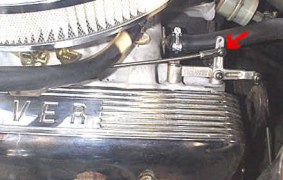 |
Using the normal throttle cable.
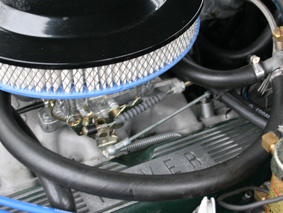 |
Option 2
Alternatively you can use the throttle cable supplied with the kit.
It is fitted to the Weber carb. as normal and then goes down the back of the engine towards the bulkhead.
The cable should then attach to the lever on the end of the throttle rod that crosses the bulkhead.
|
If you have anything to add to this section with details of your own vehicle's issues when fitting the Weber, we would be happy to add your comments and information to this page...
Back to Weber 500 Pages.
| Measuring Bonnet clearance |

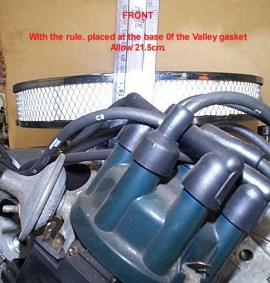 |
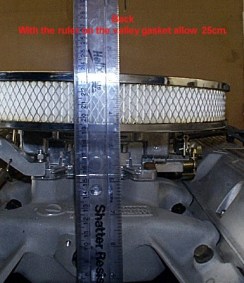 |
From the Front
With the rule placed at the base of the Valley Gasket -
Allow 21.5cm |
From the rear
With the rule placed at the base of the Valley Gasket - Allow 25cm |
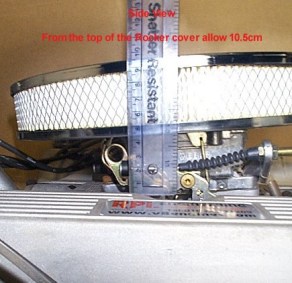 |
From the side
With the rule placed on the Rocker Cover - Allow 12cm
With all measurements we are allowing for 0.5cm extra bonnet clearance for the centre wing nut. The manifold used was the Dual plane Offenhauser (the lowest possible).
If you already have a Holley carb fitted the Weber 500 will be slightly lower on the same Manifold and is a simple conversion with no intake mods or upgrades required.
| Customer Frequent Questions |
Chris. Not only an excellent web site, but an excellent response to my questions. Your company really values customer service and it shows. Based on the information you have provided, the Weber conversion is the best option. A couple of questions.
1.What's the difference between the Edelbrock and Offenhauser manifolds, is it a matter of what Engine type I have or do they offer different performance options?
The main difference is bonnet clearance, but the higher rise Edelbrock as they tell me should have a few more BHP on the top, yet I have never noticed any difference.
2.You mention jetting the carb for individual needs at an additional cost. Is this based on the engine type or can this be done when I tune the car after installation
We can supply a jetting/metering rod kit but as we have done so many we can get close to what most need and charge a small fee to swap out the jets with what we consider you would need. If you find them too rich or weak we can exchange for another set up by post (not often needed).
3. I have been looking for electronic ignition, is the Mallory Dual Point `electronic` (please excuse my ignorance)? It seems you are suggesting doing the Carbie upgrade plus the distributor. That makes sense to me.
For sure because one will only ever be as good as the other. You can do one at a time but you'll never know what it's capable of unless you improve all possible weaknesses and spark output, for the V8 is an issue of aged stock systems for sure.
4. Do I need to upgrade the fuel pump for the Weber?
Not if you have a good stock or after market one already. You will know if it can't cope as you run out of horses at the top end and if adjusting float height does not cure it then it's a sign of a weak pump for sure.
5. What is the cost of the Mallory Dual Port and do I need to upgrade my coil?
We supply coil and Ballast resistor with it, and for up to date prices please contact us
Customer comments section now moved,
'Click here'
Even more customer feed-back, on what makes it worthwhile.
This FAQ Q/A Section is solely for information exchange only, and RPi or its contributors accept no lability for any issues arising from following up on our printed advice, or subsequent cost that may arise from the same.
For our part we do our best to check all information provided and printed is correct to the best of our knowledge. And as V8 specialists for 15 years we don't get it wrong often.
. |
|
|
links to other FAQ pages
[ V8 Engine Fitting Information ] [ Rover 3.5, 3.9, 4.2 to 4.6 Conversion ] [ LPG Conversion details ] [ Fuel Injection Section ]
[ Weber 500 & SU Carbs ] [ Mallory Ignition Systems ] [ General Engine Problems ] [ General Information ] |
|
Prices do not include local EU.Tax.(VAT).
Prices & stock are subject to change without notice. Information and advice, as always, is free.
|
|
|
|